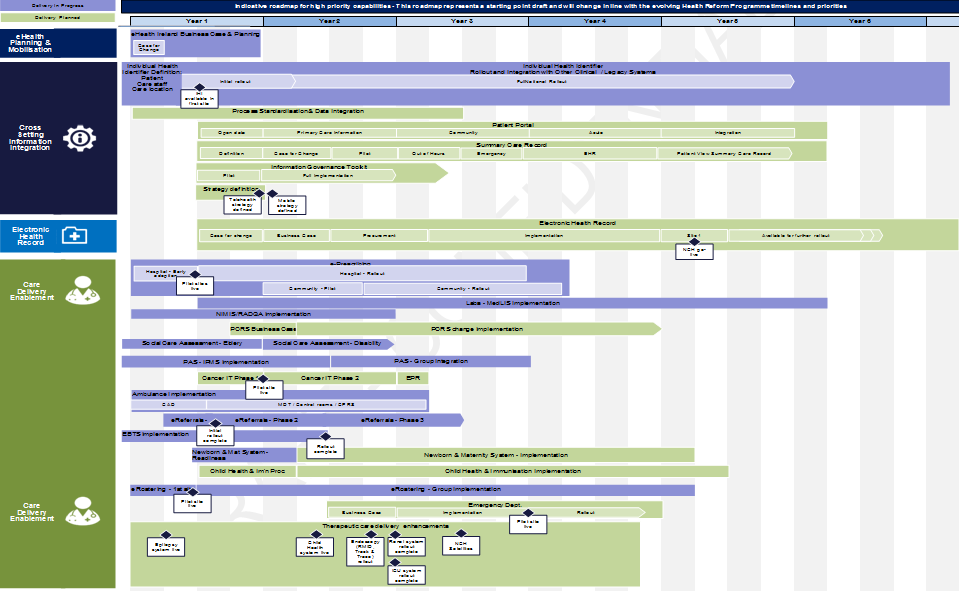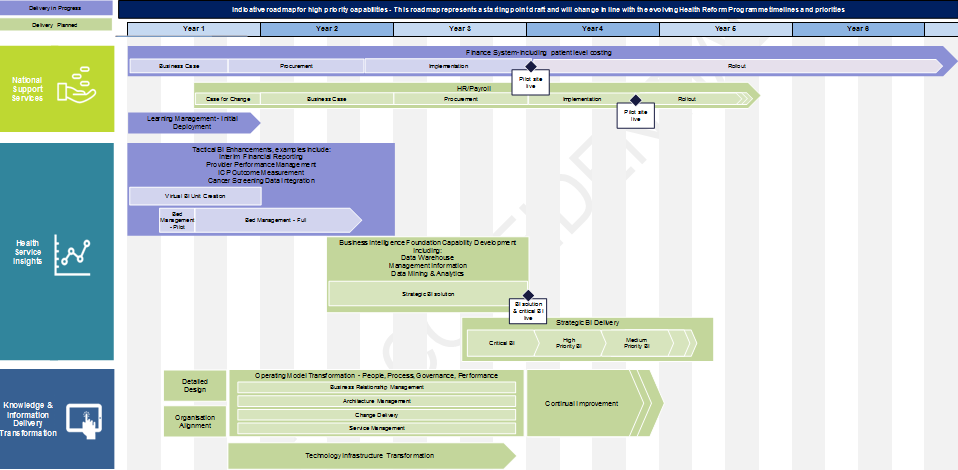eHealth Benefit Areas
The return on this investment comprises direct benefits to the patient, the healthcare delivery system and the tax payer, as well as broader positive ripple effects into the health ecosystem, SME businesses, etc. Some highlighted benefit areas include:
Health Service Delivery
- eHealth improves quality and safety of care. The six key drivers for quality improvement as outlined in the HSEs Strategic Approach to Improving Quality of Care are at the heart of the person centric approach in this strategy. The eHealth capabilities will make a meaningful contribution to improving healthcare outcomes through information based workflows and automated processes. This will increase our ability to track and measure improvements as well as providing the ability to monitor adherence to best practices thereby ensuring the provision of safe quality services and the best experience of care for all those who use our healthcare services
- eHealth brings increased clinician face time. By freeing up resources on typical administrative roles which allows clinicians to optimise individual care plans
- eHealth brings efficiency. Both to legacy healthcare systems through lower operational costs, and to new healthcare investments within existing systems.
- eHealth brings increased transparency of service outcomes. Patient safety, quality and service efficiency can be understood in a more timely manner by mining health record information
- eHealth enhances information. Providing for increased level of information flow, transparency, customisation, patient choice and responsibility-taking, as well as quantitative, predictive and preventive aspects
- eHealth puts a great focus on community care. Allows remote monitoring and management of patients from settings such as the home, reduction in travel times for patients and improvement in general convenience for both patients and care providers
Population
- eHealth enables increased population wellbeing. Extending the active life of an average employee in Ireland by 1 year can lead to a 1.5% rise in GDPii and deliver savings resulting from reduced demands for healthcare during that period of time
- eHealth empowers patients. By allowing consumers to proactively manage their own health, and improving participation in self-monitoring and chronic disease management
- eHealth enables transparency for the patient. Where they can see their own medical records, lab results and other information they have a clearer understanding of the care they are receiving
- eHealth allows better access to services. Delivering health services to remote communities and allowing online access to healthcare systems including scheduling, prescription ordering, referrals and telehealth monitoring
- eHealth improves epidemiology. Improving the ability to support management of public health interventions and the availability of high quality data sets which can be readily mined through valuable longitudinal studies to inform national policy.
Irish Economy
- eHealth makes health delivery cheaper. eHealth enables transition of care from relatively more expensive acute hospital setting to community based care and self-care – reducing the overall cost to the system. More efficient, automated processing also makes each visit cheaper.
- eHealth opens up new markets. The size of the internal eHealth-related market in Ireland is forecasted to be €42-€88 million by 2025 while the estimated size of the market potential for direct eHealth exports from Ireland are expected in the region of €559-€573 million per annum through 2020iii
- eHealth creates jobs. Once developed, eHealth services are imminently exportable with potentially 2,360 new full-time jobs and an exchequer impact of approximately €135 millioniv
- eHealth fuels entrepreneurships and start-ups. Ireland is well positioned to capitalise on the growth potential within the eHealth sector with advocated incentive schemes and the presence of agencies such as the Digital Hub Development Agency and the National Digital Research Centre
- eHealth increases Foreign Direct Investment (FDI). The industry cuts across many industry sectors including Technology, medical devices, pharma/bio and financial services who all invest heavily in eHealth.
Benefits Realisation
With a substantial investment at stake, and such a vast ranging benefits potential to be realised, it is important that the programme business case is underpinned by a strong benefits realisation framework and practices. Core tenets of this include:
- Business case rigour for each programme to justify investment
- Robust quality assurance of the cost side of the business case – estimates, risks etc
- Clear ownership of benefits definition and realisation by Clinical and Operational leadership within the healthcare delivery system
- Tangible and measurable plan to realise benefits
- Roles of different stakeholder groups in assuring that benefits are actually realised – including:
- Health service management and clinicians as business case sponsors
- Knowledge & Information function as the delivery engine
- Local Knowledge & Information management and resources in hospitals and other care settings as the ‘benefits realisation officers’, ensuring successful business adoption and implementation
The indicative delivery roadmap is set out below, and will be refined in light of evolving overall reform programme plans.


